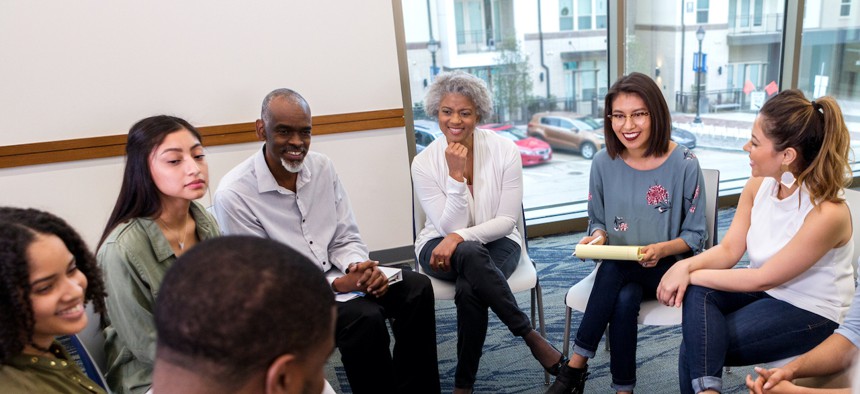Shifting Power Can Help Local Governments Partner With Communities to Achieve Racial Equity

SDI Productions via Getty Images
COMMENTARY | City and county leaders should create more opportunities for people of color to participate in the policymaking process.
This story was first published by the Urban Institute. Click here to read the original version.
The Black Lives Matter movement beckoned policymakers and community leaders across the country to prioritize equity, and many have opened their eyes and ears to the alarming disparities in the United States as a result. But some still struggle with how they can address these inequities. Although the task can seem daunting, policymakers, local leaders and community residents can start by finding ways to shift the historic power imbalance between communities and those who make the decisions and policies affecting these communities.
The history of local policymakers and researchers engaging community residents—particularly when policies affect the lives of people of color—is one of power imbalance. Local policies aren’t created in a vacuum; they are shaped by people who, historically and today, often don’t share the lived experiences of communities of color. Segregation, race-based voting restrictions and regressive taxes have kept people of color at arm’s length from making policy decisions.
Advancing the new era of community action and ensuring people of color are at the decision-making table require a power shift. Recently, the Urban Institute published a toolkit that can equip local government agencies and researchers with the strategies needed to collaborate with community residents as fellow experts.
The toolkit demonstrates the following five actionable principles drawn from community-engaged methods, a research-based platform for treating community residents as valued collaborators in shaping the future of their communities. These principles can guide local governments as they use community engagement to drive racial equity in operations, research and policy.
1. Empower Historically Excluded Voices
Local governments can begin to repair power dynamics that block or undermine community participation in the policymaking process by centering the experiences of people of color. With more voices in the room, local governments can better transform—and inform—the decision space. Existing powerbrokers should open decision-making spaces and share power with marginalized residents, using participatory planning to set budgets and listening to the guidance of community residents when designing, implementing and evaluating public services and programs. When efforts aimed at racial equity and community engagement come together, local governments can make operations more transparent, show greater accountability to the public and strengthen community ties.
2. Recognize People’s Intersectional Identities
People see and experience the world differently, depending on characteristics like class, disability, gender, sexuality, family structure, immigration status, justice involvement, and more. These characteristics intersect and give rise to complex patterns of exclusion. Understanding intersectionality, a term popularized by Kimberlé Crenshaw, is critical for transforming policymaking norms, structures, and systems. Disaggregating data by race, ethnicity, gender, or other categories can better ensure programs have a true picture of community needs and show how a policy could affect people differently within the same community.
3. Understand Historical Context And Challenge Pervasive Stereotypes
Understanding the root causes of inequities and the history of government response begins with analyzing the historical context. Knowing the backstory can inform corrective and proactive policies. The Portland, Oregon’s auditor’s office uses a racial equity plan to spotlight how their municipal auditing process could overlook or perpetuate inequities in areas like police misconduct.
Historical context can also guide policy reform or implementation. Reducing or eliminating fines and fees for low-level offenses is one way local governments can challenge pervasive stereotypes. Fines and fees intended to discourage minor offenses and generate public revenue are tied to historical practices aimed at controlling formerly enslaved people who were perceived as lazy or unproductive during the post-emancipation era. By sharing power with community residents at the policymaking table, local governments can avoid continuing exploitative and outdated stereotypes that penalize people of color and can instead find more equitable ways to raise revenue.
4. Compensate Community Residents For Their Expertise And Efforts
Prioritizing residents’ aspirations and ideas can lead to opportunities for residents to work as contributors, participants, and reviewers in policy and program initiatives. But residents often don’t receive compensation or attribution for their contributions. As with any consultant or service provider, compensation signals the value of a resident’s expertise and efforts in the community-government relationship. Compensation can take many forms, including payment for the residents’ time, transportation costs, child care, or other in-kind service and supports.
5. Develop Accountability Measures For Sustainable Systems Change
Communities expect local governments to carry out their responsibilities and fulfill the promises made to the public. Checkpoints for accountability are critical to ensuring equity commitments at the local level are actionable and sustained.
Sharing data, methods, timelines and program limitations are necessary to build authentic community engagement and demonstrate accountability. Establishing a process for sharing information with community residents and following up with them after their feedback is received enables residents and policymakers to jointly assess progress and weigh in on needed changes. And sharing metrics using visually engaging tools, such as investment tracking dashboards or StoryMaps, can help visualize root causes and how a community’s assets could be incorporated into solutions.
Seeking racial equity in the U.S. is hardly a new pursuit. But new, emerging opportunities for local governments across the country have invigorated the desire to partner with community residents for change. By valuing and drawing on community expertise, local governments and researchers can collaborate to shift power dynamics and—with community members at the table—create policies and programs that dismantle structural racism and serve all people equitably.
Sonia Torres Rodríguez is a research analyst in the Metropolitan Housing and Communities Policy Center at the Urban Institute. John Sankofa is a communications specialist in the Office of Race and Equity Research at the Urban Institute.
NEXT STORY: ‘Historic’ Funding to Help Struggling Farmers, Develop New Ag Leaders





